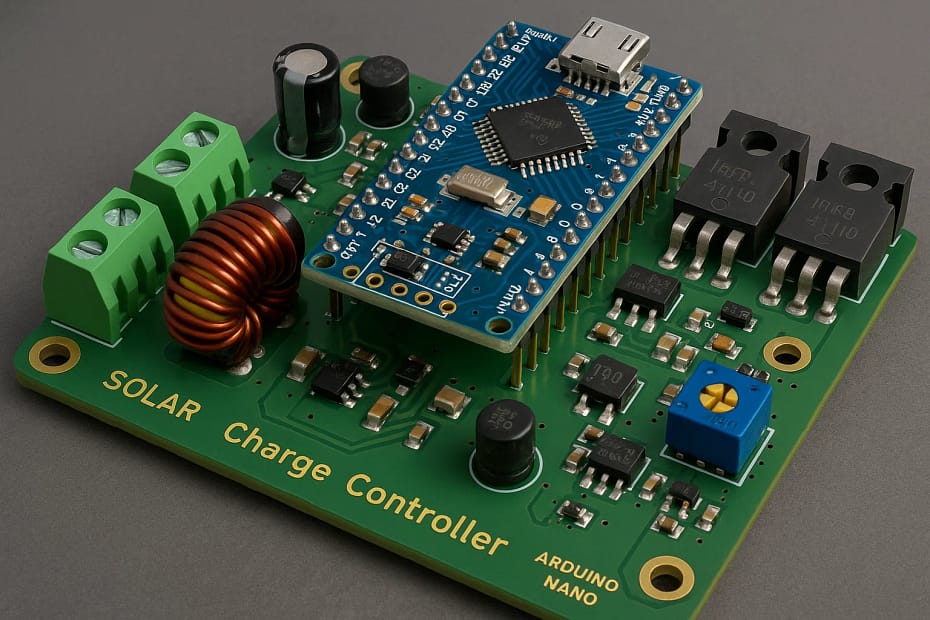How to Make an MPPT Solar Charge Controller with Arduino Nano.
An MPPT (Maximum Power Point Tracking) solar charge controller is a device that maximizes the power output from a solar panel by adjusting the panel’s operating point to match the maximum power point (MPP). Building an MPPT controller with Arduino Nano is an exciting project that helps you understand solar energy systems and electronics. This blog will guide you step-by-step through the process of building your own MPPT solar charge controller.
Materials for the Project
- 1 x ARDUINO NANO
- 1 x ACS712 Sensor 1 x MC34063 IC
- 5 x 75N75 Mosfet
- 1 x 1N5809 Diode
- 2 x MBR2045CT Diode
- 1 x LED
- 2 x PC817 Optocoupler
- 3 x Push Buttons
- 1 x 330 uH Inductor
- 1 x inductor
- 1 x 1n Capacitor
- 1 x 470u Capacitor
- 1 x 1000u Capacitor
- 1 x 10k Thermistor
- 4 x 5k Trimpot
- x 470R Resistor
- 3 x 100R Resistors
- 1 x 1R Resistor
- 6 x 10k Resistors
- 1 x 3.3k Resistor
- 2 x 47k Resistors
- 1 x 1k Resistor
- 2 x 2 Pin Terminal Block
Download Circuit Diagram
Applications of MPPT Solar Charge Controllers
MPPT (Maximum Power Point Tracking) solar charge controllers are used to optimize the energy harvested from solar panels and provide more efficient charging to batteries. These controllers are essential in various solar energy applications, especially when operating with a solar array to charge a battery. Some common applications of MPPT solar charge controllers include:
1. Residential Solar Power Systems
Home Solar Energy Systems: MPPT charge controllers are used in residential solar energy systems to ensure maximum efficiency in solar power harvesting. They track the solar panel’s maximum power point and adjust the charging process to deliver the most power to the battery.
Battery Charging: MPPT controllers are ideal for charging deep-cycle batteries used in off-grid homes, providing steady, efficient charging even during periods of low sunlight.
2. Off-Grid Solar Systems
Remote Locations: In remote areas where electricity from the grid is unavailable, off-grid solar systems rely on MPPT controllers to maximize solar energy harvesting, providing power for lighting, water pumping, or communication equipment.
Solar-Powered Homes & Cabins: For vacation homes or cabins off the grid, MPPT controllers ensure optimal battery charging, so power is available even when sunlight fluctuates.
3. Solar-Powered Vehicles
Electric Vehicles (EVs): MPPT controllers are used in solar-powered electric vehicles or hybrid systems that use solar panels to recharge onboard batteries. The controller helps maintain the vehicle’s battery health while charging optimally.
Solar Boats & RVs: Many solar-powered boats or RVs use MPPT controllers to power onboard appliances. The controller ensures the solar panel system is always operating at its maximum efficiency, regardless of environmental conditions.
4. Solar-Powered Water Pumping Systems
Agriculture: In agricultural setups, MPPT controllers optimize solar-powered water pumping systems. Farmers use these controllers to ensure the solar system provides the required power to pump water from wells, rivers, or reservoirs for irrigation, even during cloudy days.
Remote Water Supply: In remote locations without electrical grid access, MPPT controllers enable solar-powered water pumping, reducing dependency on diesel or petrol generators.
5. Commercial Solar Power Systems
Large-Scale Solar Farms: In large solar power installations (solar farms), MPPT controllers ensure each solar panel operates at its maximum power point. These systems may have hundreds or even thousands of panels, and optimizing each panel’s performance is crucial to maximize energy generation.
Commercial Solar Applications: Commercial buildings with rooftop solar installations benefit from MPPT controllers to increase the overall power output and reduce energy costs.
6. Solar Street Lighting
MPPT controllers are commonly used in solar street lighting systems, ensuring the solar panels charge the batteries efficiently, providing enough energy to keep street lights on throughout the night, even during cloudy weather or winter months.
7. Portable Solar Systems
Camping & Outdoor Use: MPPT controllers are found in portable solar kits used for camping, outdoor activities, or emergency backup power. These controllers help make the most out of limited solar exposure, charging portable batteries that power small devices like lights, phones, or laptops.
Working Explanation of MPPT Solar Charge Controllers
The primary function of an MPPT (Maximum Power Point Tracking) charge controller is to maximize the amount of energy extracted from a solar panel and delivered to a battery. Here’s how it works:
1. Solar Panel Characteristics
Solar panels have a unique voltage-current (V-I) characteristic curve. This curve shows how the voltage of a panel varies with current and is highly dependent on the solar irradiance (sunlight intensity) and temperature. The point at which the panel produces the most power (P = V x I) is called the Maximum Power Point (MPP).
When sunlight is optimal, the solar panel’s output is near its maximum power point.
In cloudy or changing conditions, the maximum power point moves, and if the panel is not operating at that point, it could be underperforming.
2. MPPT Algorithm
The MPPT charge controller tracks this changing maximum power point in real-time. It does so by continuously monitoring the voltage and current from the solar panel and adjusting the system to maximize power output. The MPPT algorithm works by:
Perturb and Observe (P&O): This is the most widely used method. The algorithm perturbs (slightly changes) the duty cycle of the Pulse Width Modulation (PWM) signal, which controls the switching of the MOSFET (or another switching element). It observes whether the power (P = V x I) increases or decreases. Based on this, it adjusts the duty cycle until it reaches the maximum power point.
Incremental Conductance (IncCond): This algorithm compares the instantaneous voltage and current to their derivatives to find the maximum power point, which is particularly effective in situations where the solar irradiance is fluctuating.
3. PWM Control of the MOSFET
MPPT controllers use Pulse Width Modulation (PWM) to regulate the charging process. PWM is a technique where the MOSFET (Metal Oxide Semiconductor Field-Effect Transistor) is switched on and off rapidly, controlling how much voltage and current are delivered to the battery.
Increasing the duty cycle: When the solar panel’s power is below the maximum power point, the duty cycle of the PWM is increased, allowing more current to flow through the battery.
Decreasing the duty cycle: When the power goes beyond the maximum power point, the duty cycle is reduced to prevent overcharging and to track the optimal point.
4. Battery Charging Process
Once the MPPT controller finds the maximum power point, it uses the PWM control to adjust the amount of energy transferred to the battery. The controller ensures that the battery is charged at the correct voltage and current, based on its type (lead-acid, lithium-ion, etc.).
Charging Control: The MPPT controller ensures that the battery does not overcharge by constantly monitoring the battery’s voltage and adjusting the input from the solar panel accordingly.
Efficiency: MPPT controllers can increase the efficiency of solar systems by 20-30%, especially under non-ideal conditions such as cloudy weather or when the panel’s voltage does not match the battery’s charging voltage.
5. Additional Features
Many MPPT charge controllers also include safety features like overvoltage protection, reverse polarity protection, and temperature monitoring to prevent damage to the system and increase its lifespan.
In Summary:
MPPT solar charge controllers play a critical role in solar power systems by tracking the maximum power point of the solar panel, adjusting the duty cycle of the PWM signal to optimize the charging process, and efficiently transferring energy to the battery. These controllers are used in residential, commercial, and off-grid applications to maximize solar energy output, improve battery life, and enhance overall system efficiency.



